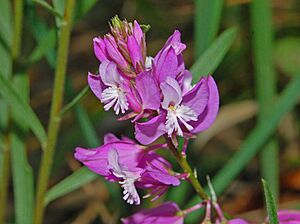Polygala vulgaris facts for kids
Quick facts for kids Polygala vulgaris |
|
|---|---|
 |
|
| Scientific classification | |
| Genus: |
Polygala
|
| Species: |
vulgaris
|
| Synonyms | |
|
Polygala oxyptera (Rchb.) |
|
The Polygala vulgaris, often called the common milkwort, is a pretty wild flower. It's a herbaceous perennial plant, which means it has soft, green stems and comes back year after year. It belongs to the Polygala group of plants in the Polygalaceae family.
Contents
What it Looks Like
The common milkwort usually grows between 7 and 35 centimeters tall, which is about the size of a ruler to a bit over a foot. Its stems have many branches and feel a bit woody near the bottom.
It has leaves that grow in an alternating pattern along the stem. These leaves are pointed, smooth, and typically about 2 to 4 millimeters wide and 10 to 20 millimeters long. The leaves near the bottom are shaped like a spoon, while the ones higher up are more like a spear.
The Flowers
The flowers of the common milkwort grow in long clusters at the top of the plant. They are usually a beautiful blue or violet color, but sometimes you might find rare purple ones.
Each flower has five sepals, which are like small leaves that protect the flower bud. The three outer sepals are small and green, but the two inner ones are much bigger and often look like petals themselves. These inner sepals are usually shorter than the actual petals.
Inside the flower, there are eight stamens (the parts that make pollen). Their stalks are joined together to form a tube. Two tiny petals are also connected to this tube. The third petal is on the lower side of the flower. It's larger and has a fringed, or frilly, edge.
You can usually see common milkwort flowers blooming from May through July.
Similar Plants
The common milkwort looks a lot like another plant called the heath milkwort (Polygala serpyllifolia). The main difference is that in the heath milkwort, the inner sepals are usually longer than the petals.
Heath milkwort can be blue, violet, or purple, but never white. Because milkworts can be found in four different colors (blue, violet, purple, and white for common milkwort), people in Ireland sometimes call them the 'four sisters'.
Where it Grows
This plant is found in many places! It grows across Europe and in parts of Asia, all the way to Japan. You can also find it in some areas of the United States, like Oregon and Michigan.
Where it Lives
Common milkwort loves to grow in sunny spots. You can often find it in meadows, on hillsides, at the edges of forests, in heathlands, and in grasslands. It particularly likes areas with chalky soil. It can grow from sea level all the way up to high mountains, about 2200 meters (over 7,200 feet) high!
Cultural Stories
In Scandinavia, people used to call this flower Freya's hair, named after a goddess from their old stories. But after Christianity came to the area, the flower was renamed after the Virgin Mary.
Traditional Uses
Long ago, writers from ancient times and the Renaissance period wrote about common milkwort. They believed that if you made a special drink from the plant, it could help mothers produce more milk for their babies.
Gallery
See also
 In Spanish: Polígala común para niños
In Spanish: Polígala común para niños








